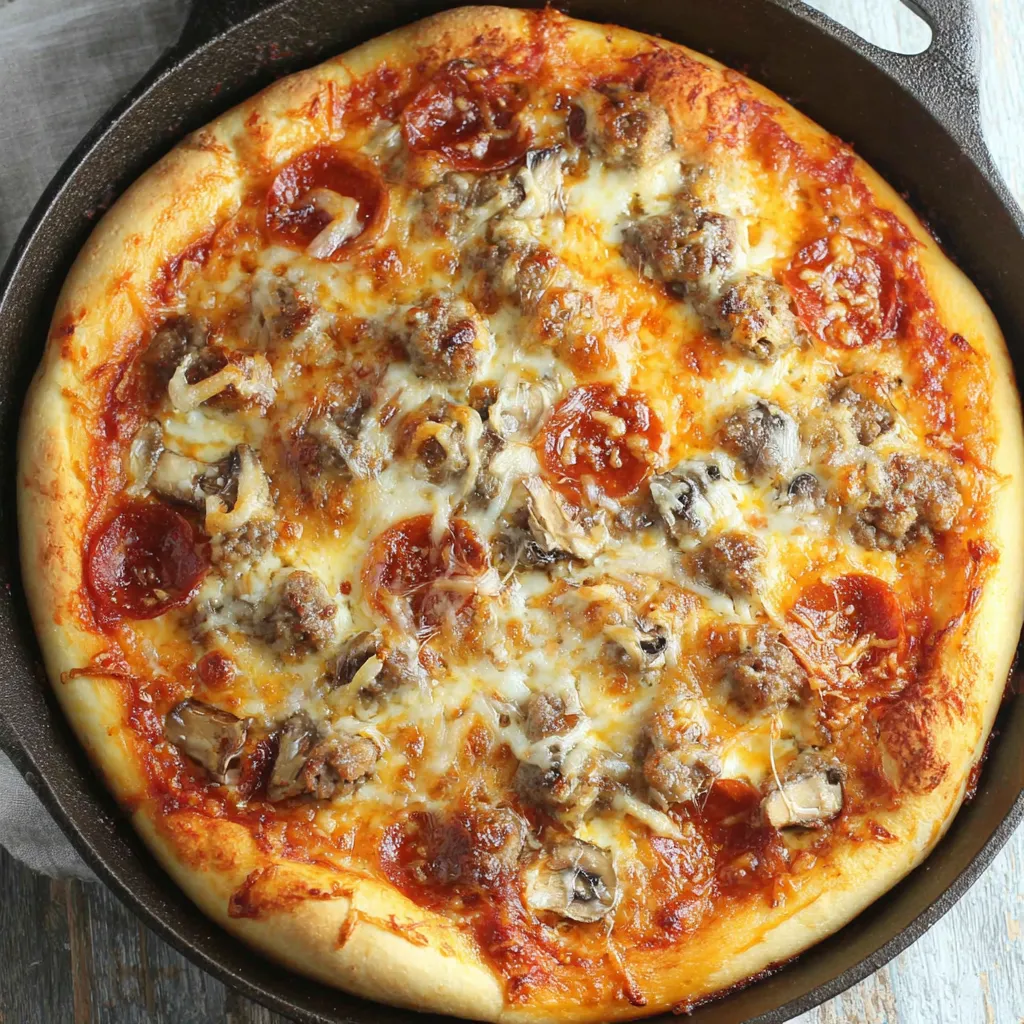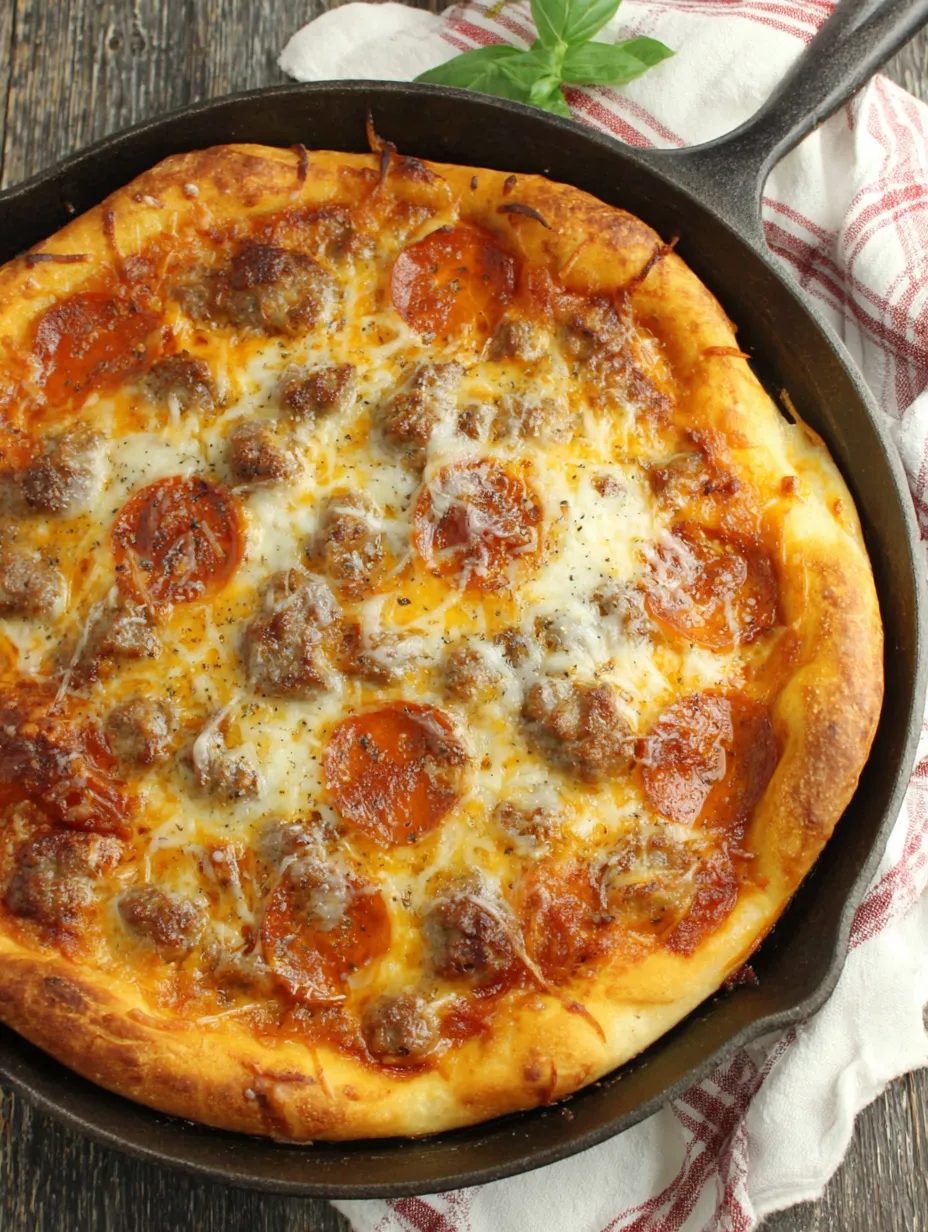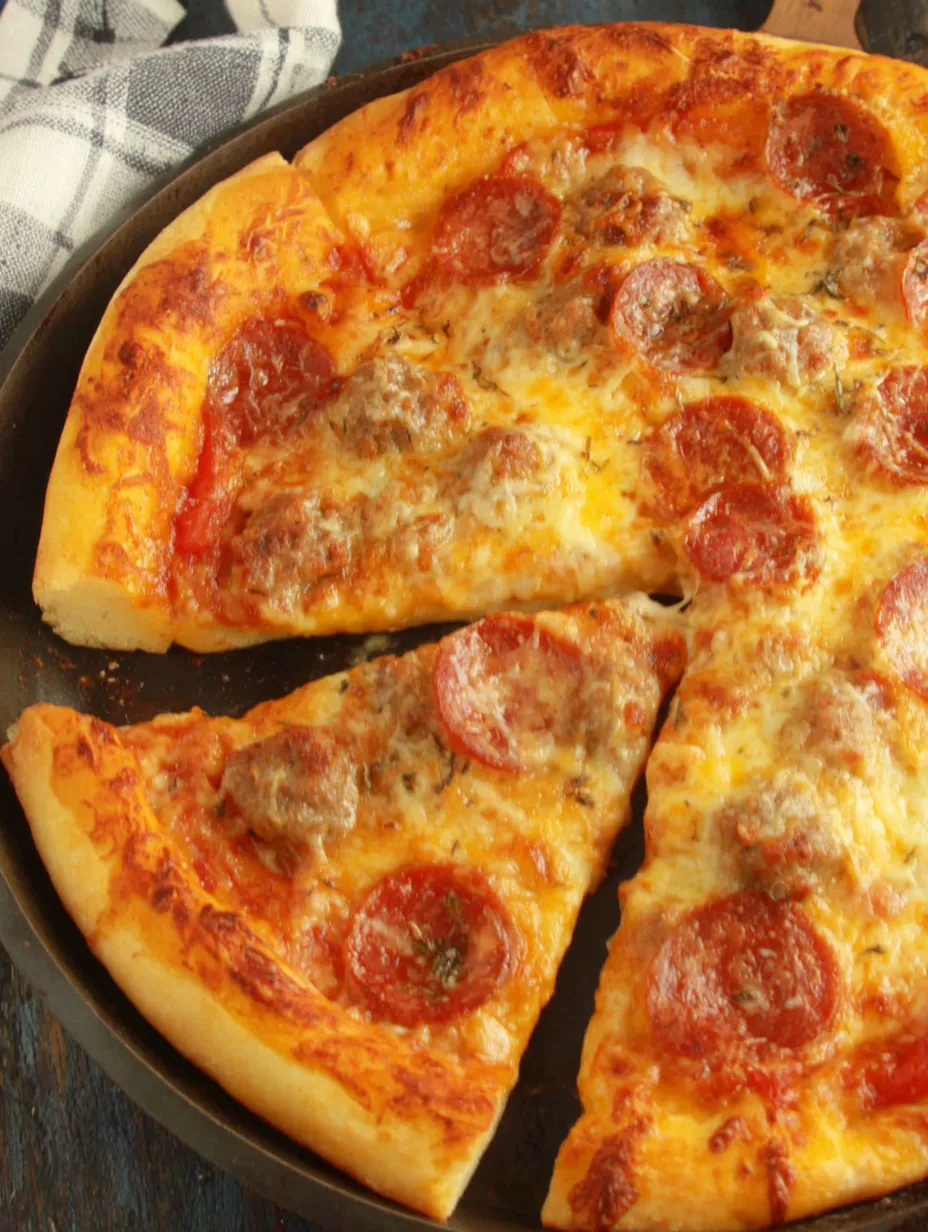 Save
Save
There is nothing quite like the satisfaction of pulling a bubbling cast iron pizza from the oven. The crispy golden crust, gooey cheese, and heaps of toppings make this a go-to family favorite for pizza night. Whether I use homemade dough or a shortcut from the store, pizza in a cast iron skillet always comes out perfectly crisp on the bottom and soft in the middle.
My family cheers every time I set a hot skillet in the center of our table. I first tried cast iron pizza during a summer storm and it instantly became our Saturday ritual because everyone can help with the toppings.
Ingredients
- Warm milk: creates a tender chewy dough and helps activate the yeast. Use whole milk for richness
- Active dry yeast: gives lift and flavor to the crust. Always check the expiration date to make sure it is fresh
- Eggs: make this dough softer and richer than many pizza doughs. Let them come to room temperature for even mixing
- Granulated sugar or honey: activates the yeast and adds a subtle touch of sweetness
- Extra virgin olive oil: adds flavor and creates a delicate crust. Choose high-quality oil for the best taste
- All-purpose flour or 00 pizza flour: forms the structure. 00 flour will yield a silkier crust if available
- Salt: enhances all the flavors. Use fine sea salt to dissolve easily
- Tomato sauce: provides the classic pizza base. Go for a thick smooth sauce without added sugar
- Shredded mozzarella: gives gooey melt and browns beautifully. Whole milk mozzarella has the best flavor
- Your favorite toppings: like pepperoni Italian sausage vegetables or ground beef. Choose fresh sliced or cooked options for the best texture
- Grated Parmesan: adds sharpness on top. Buy a wedge and grate it yourself for the real deal
Step-by-Step Instructions
- Mix the Wet Ingredients:
- Pour warm milk into a mixing bowl. Add lukewarm water active dry yeast and sugar or honey. Stir together and let the mixture sit for a few minutes until foamy. Add eggs and olive oil then mix again
- Make the Dough:
- Add flour and salt to the bowl. Use a mixer with the beater attachment to combine on medium to high speed for several minutes. Scrape the bowl often for even hydration until a shaggy dough forms
- Knead and First Rise:
- Turn the dough onto a floured surface and knead gently by hand until smooth and elastic. Shape into a round. Lightly oil your mixing bowl place the dough inside and cover. Let the dough rise in a warm spot until doubled
- Punch Down and Second Rise:
- Deflate the dough to release air bubbles. Recover and let it rise again for another hour so you get that classic open crumb and chew
- Shape the Bases:
- Divide dough into four equal pieces. Shape each into a round and rest for fifteen minutes under loose plastic wrap. Roll each round to fit your cast iron skillet keeping edges thicker for a prominent crust
- Prepare the Skillet:
- Brush the skillet well with olive oil. Press dough into the pan shaping the crust up the edge. Let it rise again covered for an hour for extra puff
- Top and Bake:
- Brush the crust edge with egg wash. Spread tomato sauce across the dough leaving the border bare. Sprinkle with mozzarella and arrange your favorite toppings generously. Bake in a very hot oven until the crust is deep golden and cheese is bubbling and brown on spots
- Finish and Serve:
- Sprinkle with fresh grated Parmesan cheese while hot. Let pizza cool a few minutes before slicing to get crisp edges
 Save
Save
My favorite part is that first sprinkle of Parmesan over piping hot pizza. Sometimes my kids stand right by the skillet just for those extra bits of cheesiness. The memory of everyone piling on their own toppings is a tradition we always look forward to.
Storage Tips
Let leftover pizza cool completely then stack slices between parchment or wax paper before stashing in an airtight container. In the fridge it lasts three days. If you want to save dough for later lightly coat balls with oil and seal in a bag for up to three days chilled or a month frozen. Thaw overnight for best results.
Ingredient Substitutions
Do not have whole milk. Use two percent or even part water part milk in a pinch. Any type of pizza cheese works in place of mozzarella including provolone or fontina. For a vegan version use egg replacer and dairy-free cheeses. Thick tomato puree stands in for tomato sauce if you prefer a chunkier base.
Serving Suggestions
Serve cast iron pizza hot out of the pan with a quick green salad for balance. For dipping offer small bowls of extra tomato sauce or garlic oil. I love setting out bowls of different toppings and letting everyone customize their corner of the pizza before baking.
 Save
Save
About Cast Iron Pizza
This style of pizza is especially beloved in parts of New England where Greek-style dough is common. Cooking pizza in a well-seasoned cast iron creates unbeatable crust texture and also makes it possible to bake at home without a pizza stone. Pizza night in our house is a hands-on event where everyone takes pride in making their own pan masterpiece.
Recipe FAQs
- → What type of dough is best for cast iron pizza?
Both homemade dough and store-bought options work well. A Greek-style dough yields a chewy, airy crust, while 00 flour gives an authentic texture.
- → How should the cast iron skillet be prepared?
Grease the skillet lightly with extra virgin olive oil before adding the dough. This helps prevent sticking and promotes a golden crust.
- → Can I use different cheeses and toppings?
Absolutely. Mozzarella is classic, but adding cheddar, provolone, or Parmesan gives extra flavor. Choose any toppings you enjoy.
- → What oven temperature gives the best results?
Bake at a high temperature, around 500°F (260°C). This ensures the crust becomes crisp and the cheese bubbles nicely.
- → How do I store leftover pizza or dough?
Store leftover pizza in the fridge for up to 3 days. Dough can be refrigerated or frozen for later use—let it come to room temperature before baking.
